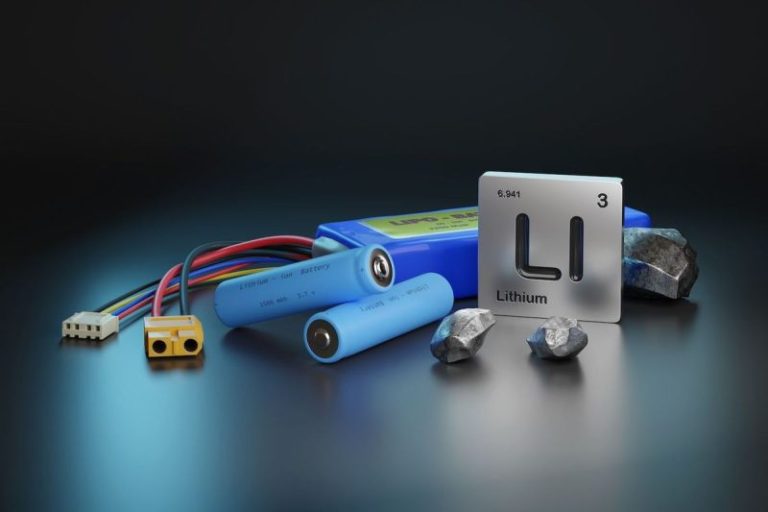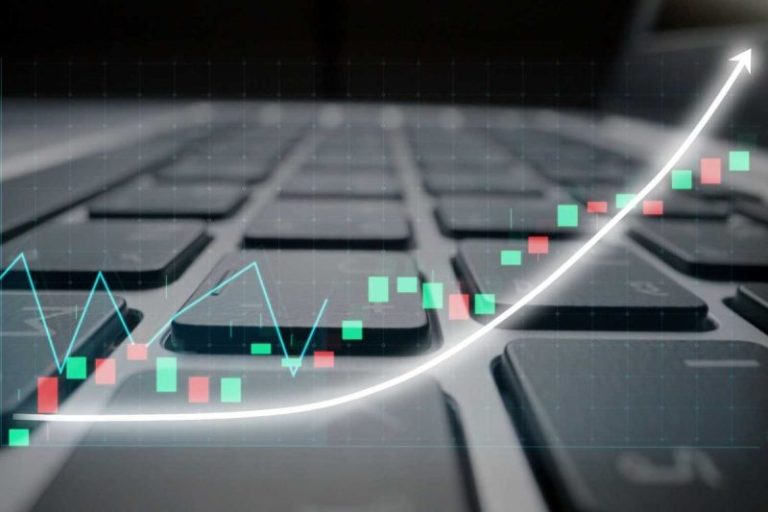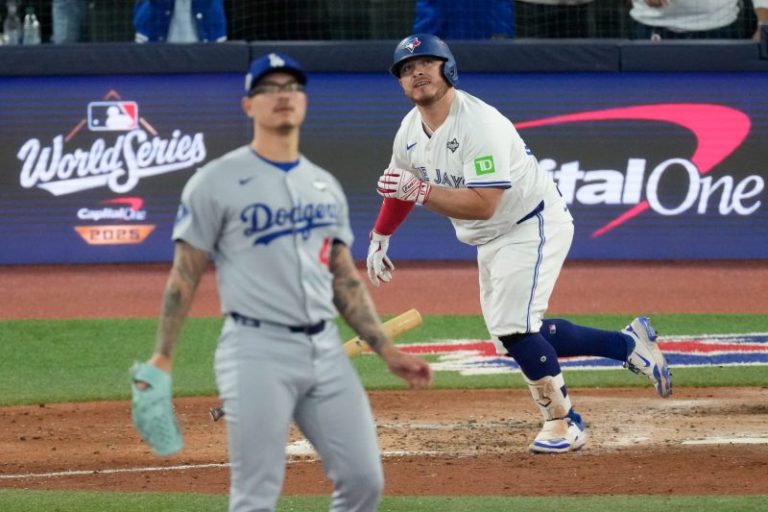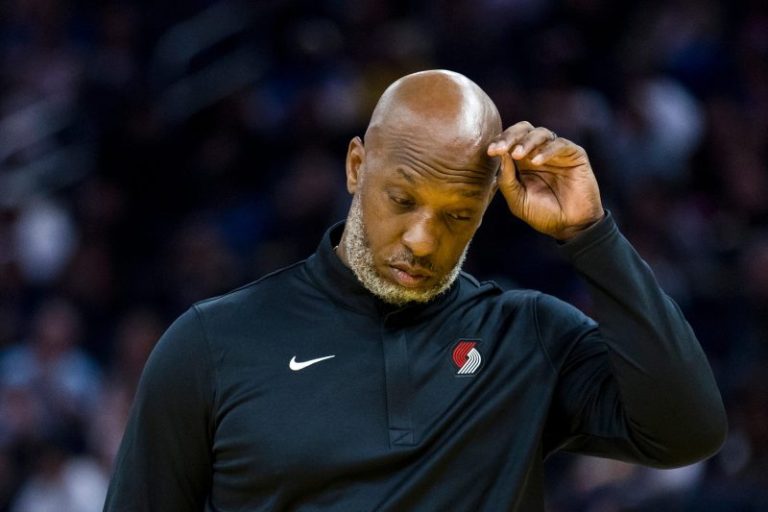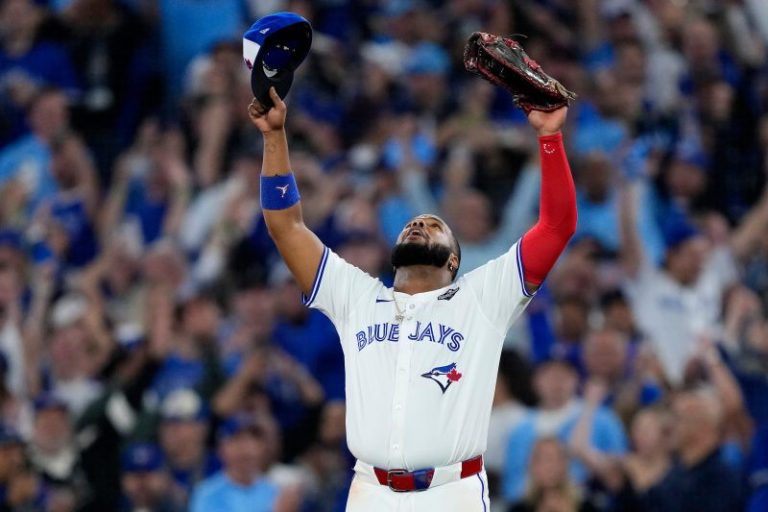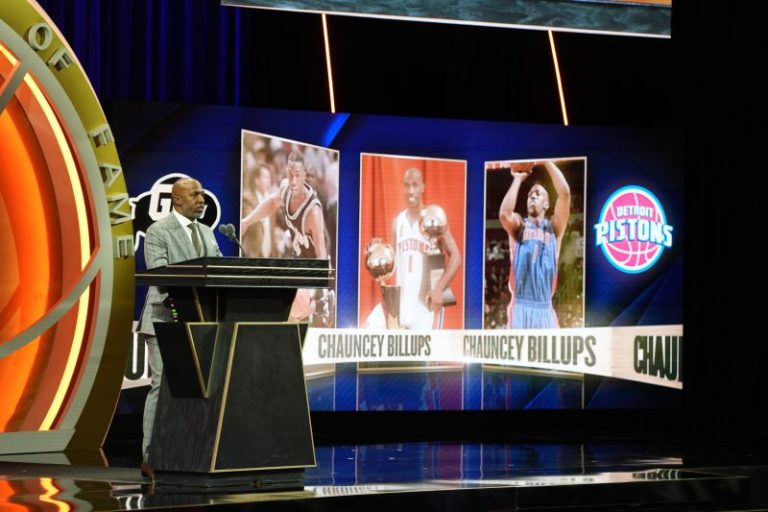TORONTO — It was a 12-batter onslaught, a beatdown that started with a leadoff walk, accelerated with a grand slam that made World Series history and ended with a pile-on two-run homer from the player that perhaps best exemplifies just how suffocating these Toronto Blue Jays are.
And now the Los Angeles Dodgers will be playing uphill in the World Series for the first time in their quest to produce back-to-back championships.
The locals waited 32 years for a Fall Classic contest, and while it’s perhaps short-sighted to say the wait was worth it, for a few frenzied minutes Friday night, a case could be made.
Alejandro Kirk, the Blue Jays’ beloved 5-foot-8 catcher, recorded the first hit of the inning – a single to put two runners on against Dodgers starter Blake Snell.
And by the time he provided the capper – a two-run home run off reliever Anthony Banda – it was already garbage time.
In between, the Blue Jays dipped into their bench three times – a pinch-runner for Bo Bichette, who drew a leadoff walk playing in his first game since Sept. 6 after recovering from a knee injury, pinch-hitter Nathan Lukes coming off the bench and drawing a bases-loaded walk to make it 4-2 and, three batters later, Barger.
He’d started this season in the minor leagues, was recalled April 15 to give a flagging Blue Jays club a boost, and went on to hit 21 homers.
In the postseason, he added a pivotal three-run homer in ALCS Game 6 as the Blue Jays rallied from the brink of elimination.
And then, in his first career World Series plate appearance, history.
With the bases still loaded, he pinch hit for Davis Schneider, who started because Snell was on the mound. With the Dodgers missing lefty reliever Alex Vesia due to a family emergency, the reliable Banda was the choice here.
And Barger greeted him by pouncing on a 2-1 slider, whistling it 413 feet to right center field, six rows deep into the bobbing, thrilled masses.
It was a 9-2 game, soon to be 11-2, with the final tally resulting from Shohei Ohtani’s first career World Series home run. Yet it was a game the Blue Jays had to have, cracking the facade of the Dodgers’ heretofore impenetrable pitching.
Game 2 – matching Yoshinobu Yamamoto against Toronto’s Kevin Gausman – should determine if this was a harbinger.
— Gabe Lacques, USA TODAY
Here’s how Game 1 unfolded in Toronto:
Shohei Ohtani home run pulls back a pair: Blue Jays 11, Dodgers 4
TORONTO – It was just window dressing in a Game 1 blowout, but Shohei Ohtani has another bullet point on his amazing baseball resume: First World Series home run.
Ohtani golfed a Braydon Fisher pitch down the right field line for a two-run homer in the top of the seventh inning, trimming the Blue Jays’ lead to 11-4 at Rogers Centre.
It’s certainly a welcome sight for the Dodgers, since Ohtani struck out twice and was 0-for-3 entering that at-bat, and was just 6-for-35 this postseason.
He went homerless in the 2024 World Series, as he injured his shoulder on a headfirst slide in Game 2 and was a high-profile statue in the final three games of that series.
Addison Barger grand slam blows it open for Blue Jays
TORONTO – Addison Barger made World Series history, sent Rogers Centre into bedlam and probably buried the Los Angeles Dodgers in Game 1.
Barger greeted lefty reliever Anthony Banda with a 413-foot shot to right center field, the first pinch-hit grand slam in World Series history and give the Toronto Blue Jays an 11-2 lead as they batted around in the sixth inning.
Barger has been a postseason hero this October in Toronto but he started Game 1 on the bench with lefty ace Blake Snell starting for the Dodgers. But Snell, who entered with a 0.86 ERA this postseason, did not record an out in the sixth and then the Blue Jays feasted on Dodgers relief.
Barger’s grand slam was followed by a Vladimir Guerrero Jr. single, shifting Banda into ‘wear it’ mode as the Dodgers look to Game 2.
And then Alejandro Kirk skied a fly to left field that edged over the wall, a two-run homer and the fourth time he reached base in Game 1.
The Blue Jays’ nine-run sixth was the third-highest scoring inning in World Series history.
Blue Jays go ahead in the sixth: Toronto 5, Dodgers 2
TORONTO – The defending World Series champions are finding out just how deep, versatile and dangerous the Toronto Blue Jays are.
They outlasted Blake Snell, sending him to the bench after loading the bases with nobody out in the sixth inning. They took their first lead of Game 1 on No. 7 hitter Ernie Clement’s RBI single off reliever Emmet Sheehan and extended it to two runs on their second nine-pitch at-bat of the inning, a walk to pinch-hitter Nathan Lukes.
And took full control with an RBI single from No. 9 hitter Andrés Giménez, whose hit off Sheehan extended their lead to 5-2 in the bottom of the sixth.
It’s now advantage, Blue Jays, in a significant fashion. Reliever Seranthony Dominguez retired all four batters he faced on 13 pitches and now, top set-up man Louis Varland and closer Jeff Hoffman are available to help nail down the last nine outs.
Daulton Varsho home run ties Game 1 in the fourth
TORONTO – Blake Snell is human. And the Toronto Blue Jays are right back in Game 1 of the World Series.
It was the first home run Snell had given up to a left-handed hitter this season.
The Blue Jays jolted Snell with a 1-2 punch before he could settle into the bottom of the fourth, as Daulton Varsho followed Alejandro Kirk’s wall-banging single with a first-pitch drive over the wall in dead center field to tie the game 2-2.
Snell escaped further damage by getting a pair of flyouts and striking out No. 9 hitter Andrés Giménez. But the damage was done and now it’s a new ballgame entering the fifth.
Trey Yesavage, the Blue Jays’ rookie starter, was removed after 80 pitches and four innings, replaced by lefty Mason Fluharty. But at least he cannot lose the game.
Dodgers’ Will Smith makes it 2-0
TORONTO – After 2 ⅓ innings of World Series Game 1, the Dodgers hold a 2-0 lead. So why does it feel like 20-0?
Well, Blue Jays rookie starter Trey Yesavage wobbled through a pair of innings, walking three batters in the second and third innings and giving up a run in each. At 71 pitches, he is not long for this game.
Meanwhile, the Blue Jays are ruing failing to score off Dodgers starter Blake Snell after loading the bases in the first inning. Snell escaped that jam and then got help from Ernie Clement, who singled in the second yet was thrown out trying to advance from first to third on George Springer’s infield single.
Snell entered this game with a 0.86 ERA in three postseason starts. And the Blue Jays’ best shot to get him may have already passed.
Enrique Hernandez, Dodgers strike first
TORONTO – Shohei Ohtani’s uneven postseason at the plate has continued in Game 1 of the World Series – but the Dodgers managed to push across the first run of the Fall Classic. Ohtani grounded out to leave the bases loaded in the top of the second – one inning after his leadoff strikeout – as the Dodgers took a 1-0 lead on the Blue Jays heading to the bottom of the second.
Once again, Dodgers playoff legend Kiké Hernández was the ringleader, poking a one-out RBI single off rookie Trey Yesavage to give the Dodgers a 1-0 lead. Yesavage gave up three hits and a walk in the inning, and ran a full count to No. 9 hitter Andy Pages with the bases loaded.
But Pages flailed at a slider for the second out, and Ohtani grounded to Vladimir Guerrero Jr., who outsprinted Ohtani to the bag to end the inning. .
Trey Yesavage starts, Blake Snell escapes bases-loaded jam
TORONTO — Trey Yesavage and Blake Snell crafted narratives of dominance in their respective leagues’ postseason. In the first inning of World Series Game 1, only the 22-year-old kid maintained that theme. .
Yesavage, the 22-year-old rookie making just his seventh major league start, set down Shohei Ohtani, Mookie Betts and Freddie Freeman in order in his World Series debut.
Snell, meanwhile, got a rude awakening about these Blue Jays: They put the ball in play.
Snell needed 29 pitches to escape a bases-loaded jam in the bottom of the first inning, retiring Daulton Varsho on a fly to center to end the inning.
Yet it felt like a victory for the Blue Jays. Vladimir Guerrero Jr. and Alejandro Kirk drew full-count walks and Bo Bichette, in his first at-bat in seven weeks, swung away on a 3-0 pitch and nubbed a single to right field, to the delight of a roaring Rogers Centre crowd that feted their homegrown star with chants of ‘Let’s Go Bo!’
And there’s still eight more innings of madness ahead tonight.
World Series lineups tonight
Dodgers lineup for Game 1
- Shohei Ohtani (L) DH
- Mookie Betts (R) SS
- Freddie Freeman (L) 1B
- Will Smith (R) C
- Teoscar Hernández (R) RF
- Max Muncy (L) 3B
- Enrique Hernández (R) LF
- Tommy Edman (S) 2B
- Andy Pages (R) CF
Blue Jays lineup for Game 1
- George Springer (R) DH
- Davis Schneider (R) LF
- Vladimir Guerrero Jr. (R) 1B
- Bo Bichette (R) 2B
- Alejandro Kirk (R) C
- Daulton Varsho (L) CF
- Ernie Clement (R) 3B
- Myles Straw (R) RF
- Andrés Giménez (L) SS
Is Bo Bichette playing in the World Series?
Blue Jays infielder Bo Bichette is on Toronto’s World Series roster and is batting cleanup, playing second base in the Game 1 lineup. Bichette, who is a free agent after the season, has not played since Sept. 6 due to a knee injury.
‘This has been, obviously, on my mind the entire run, just trying to get as healthy as I could be and as ready as I could be for this,’ Bichette said before Game 1. ‘I thought at one point it might be the ALCS, but once that wasn’t an opportunity, I turned my attention to hopefully having an opportunity to be here for this.
‘I don’t know if relief is the word, but I’m definitely super blessed and grateful to have this opportunity.’
Dodgers’ Freddie Freeman, son of Canadians, thrilled for Blue Jays
“They’ve invested in their team, into that stadium, the visiting clubhouse, they’ve put a lot into the Toronto Blue Jays,’ Dodgers first baseman Freddie Freeman told reporters before the World Series.
‘So to just see the city come together, and get to experience so much jubilation that they had going to the World Series for the first time in 30-plus years, you know it’s an exciting time.
“And being from Canada, it’s pretty cool.’
Kiké Hernández stats in MLB playoffs are stunning
TORONTO — It is October, and the Los Angeles Dodgers are in the World Series, and Kiké Hernández is striking baseballs with authority once again, a phenomenon that defies all logic and statistical trends amassed over a significant sample size.
“These are the games I live for,” Hernández said the day before Game 1. “In life, you get put on the planet to do certain things.
“And for me, I feel like I was put on this planet to love my family, make people laugh and play October baseball.”
— Gabe Lacques
Blue Jays manager John Schneider is Toronto lifer
TORONTO — George Springer’s go-ahead, eighth-inning three-run homer vaulted the Blue Jays into their first World Series since 1993, a span in which Schneider was in their employ as a poor-hitting minor league catcher, a coach and manager buried deep in their organization until his methodical rise resulted in him taking the managerial reins in the middle of the 2022 season.
This was a guy who managed franchise cornerstones Bo Bichette and Vladimir Guerrero many moons ago – not in Toronto, but in rookie league Dunedin, in 2017, when they were teenagers and both players and manager were four levels away from the big city.
This was the organizational grinder sticking around to finally sit in the hottest seat in the organization – and surviving in it long enough to see Game 1, 2025 World Series. — Gabe Lacques
Dodgers vs Blue Jays prediction for 2025 World Series
- Bob Nightengale: Dodgers in 6
- Gabe Lacques: Dodgers in 6
- Jesse Yomtov: Dodgers in 5
What team has the most World Series titles?
- Yankees – 27
- Cardinals – 11
- Athletics – 9
- Red Sox – 9
- Dodgers – 8
- Giants – 8
World Series national anthem singer tonight
Voices of Fire is performing the U.S. and Canadian national anthems before the opening game of the World Series.
World Series first pitch for Game 1: Cito Gaston
The ceremonial first pitch for Game 1 is being thrown by Cito Gaston, the Blue Jays’ manager for their 1992 and 1993 World Series titles.
World Series announcers
- Joe Davis, play-by-play
- John Smoltz, color commentary
- Ken Rosenthal and Tom Verducci, dugout reporters
Dodgers World Series roster 2025
Pitchers (12): LHP Anthony Banda, LHP Jack Dreyer, RHP Tyler Glasnow, RHP Edgardo Henriquez, LHP Clayton Kershaw, RHP Will Klein, RHP Roki Sasaki, RHP Emmet Sheehan, LHP Blake Snell, RHP Blake Treinen, LHP Justin Wrobleski, RHP Yoshinobu Yamamoto.
Position, two-way players (14): SS Mookie Betts, OF Alex Call, OF Justin Dean, INF/OF Tommy Edman, 1B Freddie Freeman, INF/OF Kiké Hernández, OF Teoscar Hernández, INF/OF Hyeseong Kim, 3B Max Muncy, DH/P Shohei Ohtani, OF Andy Pages, INF Miguel Rojas, C Ben Rortvedt, C Will Smith.
Blue Jays World Series roster
Pitchers (12): RHP Chris Bassitt, RHP Shane Bieber, RHP Seranthony Dominguez, RHP Braydon Fisher, LHP Mason Fluharty, RHP Kevin Gausman, RHP Jeff Hoffman, LHP Eric Lauer, LHP Brendon Little, RHP Max Scherzer, RHP Louis Varland, RHP Trey Yesavage.
Position players (14): C Tyler Heineman, C Alejandro Kirk, INF/OF Addison Barger, INF Bo Bichette, INF Ernie Clement, INF Ty France, INF Andrés Giménez, INF Vladimir Guerrero Jr., INF Isiah Kiner-Falefa, OF Nathan Lukes, OF Davis Schneider, OF George Springer, OF Myles Straw, OF Daulton Varsho.
Blue Jays World Series appearances
Toronto won back-to-back World Series championships in 1992 (vs. Braves) and 1993 (vs. Phillies), the only times in franchise history the club has reached the Fall Classic since coming into existence in 1977.
How many times have the Dodgers won the World Series?
The Dodgers have won eight World Series titles in franchise history – one in Brooklyn and seven in Los Angeles
- 1955 vs. Yankees
- 1959 vs. White Sox
- 1963 vs. Yankees
- 1965 vs. Twins
- 1981 vs. Yankees
- 1988 vs. Athletics
- 2020 vs. Rays
- 2024 vs. Yankees
Ontario to pull tariff ad that angered Trump ‒ but will stay up for World Series
WASHINGTON ‒ The Ontario, Canada, provincial government will continue airing an ad critical of tariffs on American TV through the weekend ‒ and then pause the commercial ‒ after President Donald Trump halted United States trade negotiations with Canada over his objections to the ad.
Ontario Premier Doug Ford, in an Oct. 24 statement, said he’s directed his team to keep airing the commercial ‒ which features remarks from the late U.S. President Ronald Reagan ‒ so it will be seen during Games 1 and 2 of the World Series, set for Friday and Saturday, October 24 and 25.
Ford said the province of Ontario will pause the ad effective Monday, Oct. 27 ‘so that trade talks can resume.’ He cited a conversation he had with Canadian Prime Minister Mark Carney to come to the decision. — Joey Garrison, USA TODAY
Dodgers vs Blue Jays World Series odds
World Series schedule 2025
- Game 1: Friday, Oct. 24 in Toronto – 8 p.m. ET, FOX
- Game 2: Saturday, Oct. 25 in Toronto – 8 p.m. ET, FOX
- Game 3: Monday, Oct. 27 in Los Angeles – 8 p.m. ET, FOX
- Game 4: Tuesday, Oct. 28 in Los Angeles – 8 p.m. ET, FOX
- *Game 5: Wednesday, Oct. 29 in Los Angeles – 8 p.m. ET, FOX
- *Game 6: Friday, Oct. 31 in Toronto – 8 p.m. ET, FOX
- *Game 7: Saturday, Nov. 1 in Toronto – 8 p.m. ET, FOX
World Series winners by year
- 2024: Dodgers
- 2023: Rangers
- 2022: Astros
- 2021: Braves
- 2020: Dodgers
- 2019: Nationals
- 2018: Red Sox
- 2017: Astros
- 2016: Cubs
- 2015: Royals
- 2014: Giants
- 2013: Red Sox
- 2012: Giants
- 2011: Cardinals
- 2010: Giants
Who won the World Series last year?
The Dodgers defeated the Yankees in five games to win the 2024 World Series.
Did Vladimir Guerrero win a World Series?
Hall of Famer Vladimir Guerrero never won a World Series title, making his only Fall Classic appearance for the Texas Rangers in 2010, the penultimate of his 16-year MLB career.
When did the Dodgers move to LA?
The Dodgers left Brooklyn after the 1957 season, playing their first game in Los Angeles in 1958.
The Giants departed New York for San Francisco at the same time, bringing the historic rivalry to the West Coast.
2025 World Series umpires
MLB announced the umpires and full schedule for the crew chosen to call this year’s World Series. Mark Wegner has been designated as crew chief for the first time. It’s his third World Series overall overall during a 25-year career.
Here’s how the umpires will line up for Game 1:
- Home plate: Will Little
- First base: Mark Wegner (crew chief)
- Second base: John Tumpane
- Third base: Alan Porter
- Left field: Adam Hamari
- Right field: Jordan Baker
- Reserve: Adrian Johnson
Dodgers vs Blue Jays World Series tickets
This post appeared first on USA TODAY


